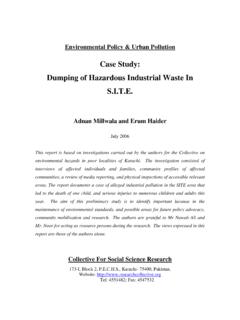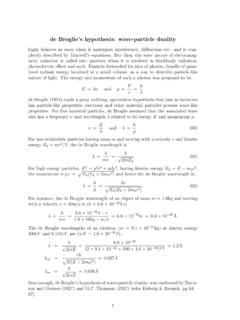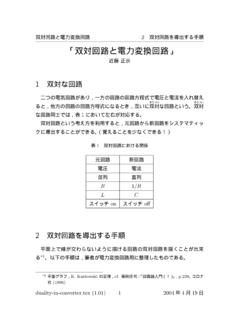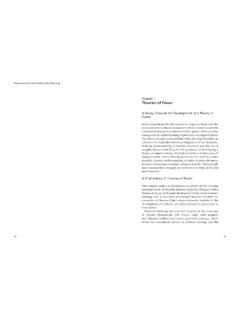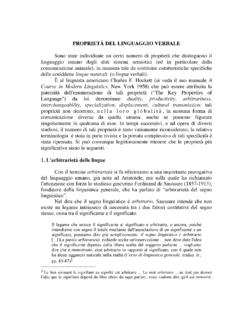Transcription of mes across the city’s population and communities.
1 1 karachi s Violence: duality and Negotiation1 Haris Gazdar Collective for Social Science Research Introduction This paper offers a series of perspectives on political conflict in karachi based on the analysis of historical data, projections and scenarios. There are many divergent views about the root causes of violence in karachi as well as possible ways of ending or reducing the violence. This paper attempts to weave a number of pertinent issues political party rivalry, ethnicity, and duality into a single narrative about dangers and possibilities in karachi . It makes extensive use of publicly available secondary data on violence, voting patterns, ethnic demography, development outcomes, and economic opportunity. 2 None of the data analysis provided here is entirely new to seasoned observers of Pakistan, Sindh and karachi .
2 What might be different here is the peculiar way in which these various elements are made to fit into a bigger story. In a nutshell, the story I wish to tell revolves around emergent trends and future scenarios of politics in karachi , Sindh and Pakistan, in that order. But the political story is shaped here by ethnic demography, class and developmental inequalities, and future economic opportunity. I will begin with the premise that much though not all violence in karachi is somehow linked to relations between the city s main political parties. However, this is not as bad as it might appear. I will reiterate using available data on voting behaviour that ethnicity remains a marker of political preference to a great degree, and has done so for a long period of time.
3 Political parties have stable support bases among ethnic groups and localities, and this too is not as bad as it might appear. Secondary data is presented to highlight changing trends and likely scenarios with respect to ethnic demography. These data suggest that karachi political parties have reason to eye future demographic patterns as threats as well as opportunities, but that threat perceptions need not be as frightening as they may appear at first glance. The city will also continue to provide opportunities to political entrepreneurs because of inequalities based on class and development outcomes across the city s population and communities. Models of urban development that are based on mega projects may not be the only way forward for parties to expand and diversify their support bases. karachi has historically been the locus of opportunity for the rest of the country, but its position within Sindh sharpens the economic dualism between urban and rural areas, agriculture and industry, and the two major ethnic groups of Sindh.
4 The city can be an 1 This discussion paper was prepared for the Round Table Forum Sustainable Development for Sustainable Peace , organized by Strengthening Participatory Organization (SPO), and held on 23 September 2011 in karachi . The author is grateful to Mysbah Balagamwala for research assistance. 2 population data from various population Censuses carried out by Government of Pakistan and election data from Dawn Election Data compiled through Election Commission of Pakistan sources 2 instrument for the development of the rest of Sindh, but also a channel through which Sindh s resources can be exploited while excluding its population from significant benefits. While the future economic scenario for Sindh looks bright on paper, it also demands great foresight on the part of the political and civil society of the province.
5 Political violence escalates According to data compiled by the Human Rights Commission of Pakistan (HRCP), over 1,100 people were killed in karachi during the first six months of 2011, of whom 490 fell victim to political conflict. 3 The Citizen s Police Liaison Committee (CPLC) which is a semi-official body that works with the police force, reported that there had been 1,423 killings in karachi between January and August 2011, compared with 1,339 such killings in all of 2010 (Figure 1). 4 The 2010 figure itself represented a ten-fold increase over a five-year period, with steep rises in every year in between. Figure 1: CPLC data on killings in karachi Source: CPLC compilation based on open sources Although CPLC data, based on public sources, do not separately identify politically-motivated killings, it is widely understood that there is close correlation between political and general violence in the city.
6 The Pakistan Institute for Peace Studies, which also relies on public sources, and reports casualties due to various forms of political violence across the country, found that ethno-political violence in karachi claimed 636 lives in 2010, compared 3 The Express Tribune, 6th July 2011. HRCP report indicates rise in killings this year [online], accessed on 22nd September 2011 4 Citizens Police Liaison Committee (CPLC), 2011. Development of crime patterns , [online], accessed on 22nd September 2011. 0200400600800100012001400160018002000199 4199519961997199819992000200120022003200 42005200620072008200920102011*Number of killings *upto to August 2011 3 with 600 lives lost in the Balochistan uprising and 2,300 deaths due to the jihadist insurgency. 5 On current trends, karachi s political violence is likely to have become comparable, in terms of lives lost, with the war with the Taliban and related jihadists in the north of Pakistan.
7 Figure 2: Homicide rate (per 100,000) based on CPLC data Source: Author s calculations based on CPLC data and population trends The period since the end of June has been particularly unstable. That was when the Muttahida Quami Movement (MQM) which is the largest political party of the city walked out of the coalition government in the Sindh province in which it had partnered with the Pakistan People s Party (PPP) and the Awami National Party (ANP), the other two parties with significant political support in karachi . Over 100 people were killed through targeted assassinations and politically-motivated ethnic killings in early July, mostly in the western quarters of the city. The situation calmed down briefly before flaring up again in mid-August, this time with much of the violence being centred in the city s south.
8 There have been targeted assassinations of local leaders or supporters of various parties. The killing of a party functionary is quickly followed up by the aggrieved group naming a rival political party as the perpetrator. This often leads to a strike call by the aggrieved group which is enforced by its armed supporters often resulting in the killing of random individuals belonging to the ethnic support base of the rival party. There have also been increasing cases of abduction, torture and murder of people suspected of being rival political supporters or of simply belonging to a rival ethnic group. This is reminiscent of the 1990s when trussed up bodies bearing torture marks turned up in gunny bags, sometimes with pieces of paper bearing gruesome messages of vendetta.
9 Besides killings of political and ethnic rivals, extortion has become particularly vicious with several cases of grenade attacks on non-compliant business premises. Ominously, casualties have recently included a number of Sindh police personnel killed or wounded while intervening in armed clashes between rival groups. 5 Pakistan Institute for Peace Studies (PIPS), 2011. Pakistan Security Report 2010 0510152025199419951996199719981999200020 0120022003200420052006200720082009201020 11*4 At moments of heightened conflict between parties the implied ethnic associations are used by armed party cadres to deliver messages to one another. Although none of the parties openly admit to ethnic violence, most observers agree that political disputes often do take an ethnic colour with attacks on ordinary citizens belonging to particular ethnic groups being used to settle scores.
10 Ethnic demography and city politics karachi is not only Pakistan s largest city it is also its most diverse in terms of its ethnic demography. In the last census carried out in 1998 under half of its residents reported their mother tongue as Urdu. They are mostly partition migrants from northern India and their descendants, who may also refer to themselves as Mohajir. Sindhi and Balochi speakers, who were the overwhelming majority in 1947, accounted for 7 and 4 per cent respectively in 1998. Punjabi-Seraiki speakers counted in as the second largest linguistic group at 17 per cent, while 11 per cent reported their mother tongue as Pushto. Over 12 per cent of the population had other mother tongues including Kachhi and Gujarati-speakers many of whom are also descendants of partition migrants, but not always self-classified as Mohajir.
